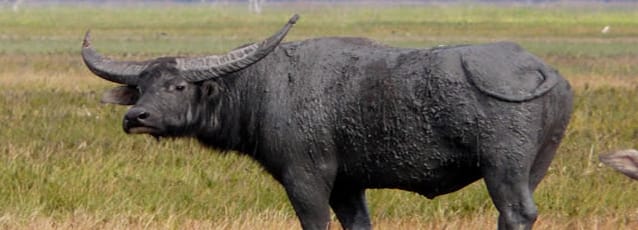WATER BUFFALO
Physical characteristics and distribution
Body length: females: 240 – 290 cm, males: 250 – 300 cm
Weight: females: 800 kg, males: 1,200 kg
Life expectancy: 20 – 25 years
Distribution: Asia
Habitat: Wetlands
Species: 1,000, endangered
Weight: females: 800 kg, males: 1,200 kg
Life expectancy: 20 – 25 years
Distribution: Asia
Habitat: Wetlands
Species: 1,000, endangered

Appearance
The water buffalo is a big, strong beef. The head is long and narrow and with small ears. The horns are horizontally and crescent-shaped bent backwards. They are significantly narrower and shorter in females than in males. The horns can reach a span of two meters. The head is set low on the body. The water buffalo stands on long, strong legs that end in wide hooves. The claws are spread wide. As a result, the water buffalo do not sink in their marshy habitat. The tail is up to 80 inches long and is provided with a final tassel. Water buffaloes have a gray, brown or black coat. Some subspecies have white marks on their legs.
Reproduction and development
At the age of one to three years, water buffalo become sexually mature, while females are usually ready to mate much earlier. In the north of Asia the mating season falls into autumn, in other areas the buffaloes are ready to mate all year round. A bull collects several cows at mating season, which he defends with a loud roar against rivals. Then he pairs with all his cows. The female is pregnant for about ten months and then gives birth to her offspring in a sheltered place. It usually brings in, sometimes two calves to the world. Water buffalo are nest-breeders. The calf is already fully developed at birth and can follow the mother after a few hours. At birth, it weighs around 37 kilograms. The cub is nursed and protected by the mother for eight months. At the age of one month, it also begins to eat solid foods. At the age of about eight months, the calf dissolves from the mother. But it remains in the same herd until sexual maturity. Young bulls are then expelled.
Lifestyle and behavior
Unlike the wild boar men, the females and juveniles live in groups. These “raids” usually consist of streams, offspring from the previous year and newlings. Young boars sometimes team up with bachelor groups.
Sensory abilities
The smell of the water buffalo is very good. He plays an important role especially at the mating season, as the bull recognizes mating females by the smell. The hearing is also well developed. Water buffalo recognize danger with their ears and can flee in time. The sense of sight, on the other hand, is weak.
Feeding
Grasses, herbs and aquatic plants are the main component of water buffalo food. He feeds exclusively vegetarian. Foliage and small branches are also on his menu. If the herd lives near humans, the water buffalos also eat cultivated crops. Water buffalo are ruminants. They usually go in search of food in small groups, which split off from the main group.
Hunting style, equipment and countries
Water buffalo are mainly hunted in Australia where there is a very good population of this wild species. The hunt for water buffalo takes place as a stalking hunt. The minimum caliber is 375 H & H.
Hunting trip Countries
IF YOU HAVE QUESTIONS OR ARE INTERESTED IN A MEDIATION OFFER FOR HUNTING TRIPS AND HUNTING ON WATER BUFFALO PLEASE CONTACT US BY EMAIL OR CONTACT FORM.
All offered trips are arranged by us and carried out by our partners as organizers.
